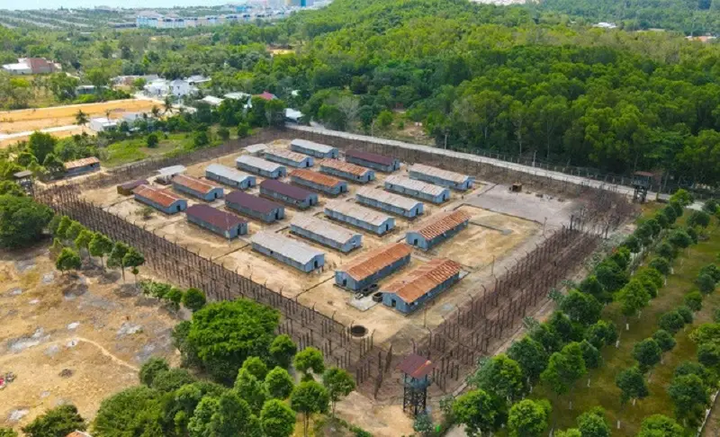1. Where is Phu Quoc Prison?
Phu Quoc Prison is located about 28 kilometers from Duong Dong town center, at 350 Nguyen Van Cu Street, An Thoi Ward.
Overview of Phu Quoc Prison (Photo: Collected)
Known during the war era as Coconut Tree Prison, this is one of the most infamous prisons in Vietnam, a place that bore witness to the sacrifices and indomitable spirit of revolutionary soldiers. In 1995, Phu Quoc Prison was recognized as a Special National Historical Relic, offering visitors a chance to explore heartbreaking and heroic stories from Vietnam’s turbulent past.
Phu Quoc Prison is a designated Special National Historical Relic
This site stands as a testament not only to the brutality of French and American colonial regimes but also to the unwavering resilience of Vietnamese revolutionaries. A visit here immerses you in an eerie atmosphere, revealing the harsh living conditions and brutal torture methods endured by prisoners.
2. The Tragic History of Phu Quoc Prison
2.1 Phu Quoc Prison during the French Colonial Period
Phu Quoc Prison was established in 1946 when French colonialists occupied Phu Quoc Island and decided to build a large prison covering 40 hectares. It became one of the largest prisons in Southeast Asia at the time, divided into several detention zones, including zones A, B, C, and D.
Inside Phu Quoc Prison (Photo: Collected)
With a strict security system — barbed wire fences, guard towers, and bright searchlights — the prison became a living "hell" for many revolutionaries. The brutal torture methods used by the French destroyed not only the bodies but also the spirits of countless prisoners. Thousands were tortured, and 99 communist soldiers lost their lives here.
The painful stories of the past still echo throughout the prison, leaving a chilling impression on every visitor who contemplates what once occurred here.
Reenactment of prisoner roll call at Phu Quoc Prison (Photo: Collected)
2.2 Phu Quoc Prison during the Republic of Vietnam Era
After the 1954 Geneva Accords, the French handed over control of the prison to Vietnamese authorities, but the horrors did not end. The Republic of Vietnam government took over and reconstructed the prison, reducing its size to only 4 hectares but increasing its cruelty. It was renamed Coconut Tree Prison and continued to detain not only revolutionaries but also patriotic civilians.
Reenactment of prisoner torture (Photo: Collected)
During this period, torture methods grew even more horrific. Prisoners were nailed through their bodies, locked inside barbed wire “tiger cages,” or thrown into dark, solitary confinement cells. Thousands perished, and tens of thousands more were left with permanent injuries.
3. Historical Remains at Phu Quoc Prison
Phu Quoc Prison is not only remembered for its painful history but also for its preserved structures, offering insight into the prison’s operation and the harsh life of its inmates. Below are key historical remains you should not miss when visiting the site.
3.1 Gate of Military Police Battalion No. 8
This is one of the remaining structures at Phu Quoc Prison. Made from iron pillars and solid bricks, the gate has been fully reconstructed to replicate its original form, representing the strict surveillance and control imposed by the military police.
3.2 Gate of Military Police Battalion No. 7
This gate, about 4.1 meters high and 0.85 meters wide, with two pillars spaced 5.9 meters apart, was where guards once stood watch over prisoners. A nearby information board provides context on the battalion’s role and activities during the prison’s operation.
3.3 Prisoners' Cemetery
Located around 1 kilometer from the main prison area, this 20,000-square-meter cemetery is the final resting place of prisoners who died during incarceration. A clenched fist monument stands atop the cemetery, symbolizing the unbreakable spirit of the revolutionaries who, despite immense suffering, never surrendered.
Fist-shaped monument at the Prisoners’ Cemetery (Photo: Collected)
3.4 Zone B2
Zone B2 is one of the main restored areas within the prison, spanning more than 17,000 square meters. It includes watchtowers, barbed wire fences, gatehouses, tiger cages, and the prisoner canteen. These were once places of imprisonment and torture. The barbed-wire “tiger cages,” where inmates were locked in sharp steel enclosures, remain one of the most haunting exhibits.
Zone B2 at Phu Quoc Prison (Photo: Collected)
You’ll also find areas such as the prison kitchen and dining hall, where prisoners endured extremely poor conditions without medical care or sanitation — stark evidence of the colonial regime’s cruelty, where inmates were treated as less than human.
3.5 Kien Van Church at Phu Quoc Prison
Though only its cement pillars and foundation remain, Kien Van Church stands as a relic of the French colonial era. Spanning over 4,000 square meters, the church once held religious ceremonies before being destroyed during the war.
3.6 Phu Quoc Prison Relics Exhibition House
The exhibition house is divided into two rooms, each displaying historical artifacts that shed light on the prison’s history.
Room 1 showcases tools and everyday items used by both prisoners and guards during the early construction of the prison.
Room 2 contains 100 documentary photographs of torture methods used by colonial forces against revolutionaries — images that reveal the enemy’s cruelty while honoring the resilience of Vietnamese patriots.
(Photo: Collected)
3.7 Sim Hill Martyrs Memorial
Located on an elevated site known as Sim Hill, this memorial pays tribute to the fallen soldiers who sacrificed their lives for national independence. The monument features two 5-meter-high wave-like structures and a sharp central pillar, symbolizing “the people who emerged from that place.” It serves as both a place of remembrance and reflection for visitors.
3.8 Prison Command Gate and Headquarters
This area has been reconstructed with reinforced concrete, featuring a corrugated iron roof and wooden windows. The main gate is made of iron bars and barbed wire, reflecting the tight security imposed by prison officials. It was the command center for overseeing operations and prisoner management, including interrogation and torture procedures.
4. Unmissable Experiences at Phu Quoc Prison
4.1 Torture Reenactments at Zone B2
Zone B2 is one of the most impactful stops during your visit. This area features lifelike mannequins of prisoners and guards reenacting the brutal torture scenes. It offers visitors a visceral sense of the pain and sacrifice endured by revolutionaries in their fight for freedom.
4.2 Torture Methods Used at Phu Quoc Prison
The torture methods showcased at Phu Quoc Prison are stark reminders of the cruelty inflicted by colonial and imperial powers. Visitors will witness displays of barbed-wire tiger cages, body nailing, and many other harsh techniques. These reenactments are carefully restored to illustrate the brutal reality of war.
Reenactment of political prisoners locked in a “tiger cage” (Photo: Collected)
4.3 Visiting the Solitary Confinement Cells
The solitary confinement cells are among the most haunting parts of the prison. These dark, airless spaces were where revolutionaries were subjected to inhumane isolation and brutal torture without medical care. The conditions inside serve as a chilling reminder of the cruelty many had to endure.
5. What Is the Historical Significance of Phu Quoc Prison?
Phu Quoc Prison not only documents the horrific crimes of French and American colonial forces, but also stands as a powerful symbol of the Vietnamese people’s unwavering spirit and resilience. Each relic and story found here speaks to the courage and sacrifice of those who gave their lives for the country’s independence.
A visit to the prison is more than a history lesson — it’s a moving tribute to the national heroes who fought and died for freedom. It invites reflection, respect, and gratitude from all who walk its grounds.
6. Tips for Visiting Phu Quoc Prison
Phu Quoc Prison is not just a historical site — it’s a deeply symbolic place, preserving cultural and historical values. To make the most of your visit and help protect the site’s integrity, keep the following tips in mind:
Dress respectfully: As this is a historical landmark, visitors are encouraged to wear modest and respectful attire.
Do not touch the exhibits: Help preserve the relics by avoiding direct contact with displayed items.
Bring food and water: The prison grounds are vast, and food and drink may not be readily available nearby.
Maintain cleanliness: Dispose of trash properly to protect the environment and preserve the site’s solemnity.
Opening hours: The prison is open from 8:00 AM to 11:30 AM and 1:30 PM to 5:00 PM.
Admission: Free of charge.
Visitors exploring the Phu Quoc Prison historical site (Photo: Collected)
>>> Nearby Attractions to Explore After Visiting Phu Quoc Prison:
Ho Quoc Pagoda: Perched on a hilltop, this is the largest pagoda in Phu Quoc. With its unique architecture and majestic mountain-and-sea backdrop, it offers spiritual peace and scenic beauty.
Sao Beach: Famous for its powdery white sand and crystal-clear waters, Sao Beach is one of the most pristine and beautiful beaches in Phu Quoc — perfect for relaxing and exploration.
Tranh Stream: Tucked away in a lush tropical forest, Tranh Stream features gentle streams, natural rock formations, and small pools, creating a serene and picturesque escape.
Phu Quoc Pepper Gardens: A unique destination where visitors can learn about the island’s signature pepper cultivation and enjoy the lush rows of green pepper trees stretching across the land.
A journey through Phu Quoc is never complete without visiting its prison — a place where history, heroism, and national pride converge, leaving a lasting impression on every traveler.



